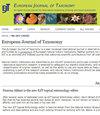Redefining the Taxonomic Boundaries of Genus Xanthomonas
IF 1.1
3区 生物学
Q3 ENTOMOLOGY
引用次数: 0
Abstract
The genus Xanthomonas primarily comprises phytopathogenic species. By carrying out deep phylo-taxonogenomics, we recently reported that the genera Xylella, Stenotrophomonas, and Pseudoxanthomonas are misclassified and belong to the genus Xanthomonas. Considering the importance of Xanthomonas/Xylella as plant pathogens and to further determine the taxonomic and phylogenetic breadth of this genus, we extended our earlier study by including all the reported genera and families in the order. This investigation revealed that at least four more genera belong to the genus Xanthomonas, with a notable case being Lysobacter, after which the family and order are named. Similarly, our investigation also allowed us to reveal the expanded taxonomic breadth of the related genus Rhodanobacter. This finding of a major related genus that lacks plant pathogenic species will allow for taxonomy-based comparative studies. The phylo-taxonogenomic revelations were further supported by complete 16S rRNA-based sequence boundaries proposed for genus delineation. Accordingly, we propose a taxonomic revision of these major and closely related genera along with their constituent families within the order Lysobacteraceae (Xanthomonadaceae). The identification of a major related genus lacking plant pathogenic species will be important in investigating the origin and success of pathogenic species/lineages in the genus Xanthomonas.黄单胞菌属分类学界限的重新界定
黄单胞菌属主要由植物致病种组成。通过深入的系统分类基因组学研究,我们最近报道了木菌属、窄养单胞菌属和伪黄单胞菌属被错误分类为黄单胞菌属。考虑到Xanthomonas/Xylella作为植物病原体的重要性,并进一步确定该属的分类和系统发育广度,我们扩展了之前的研究,纳入了该目所有已报道的属和科。调查结果表明,黄单胞菌属至少有4个属,其中溶菌属是一个值得注意的病例,并以此命名该科和目。同样,我们的调查也使我们能够揭示相关属罗丹诺杆菌的扩展分类宽度。这一发现的主要相关属,缺乏植物病原物种将允许基于分类学的比较研究。基于16S rrna的完整序列边界进一步支持了这一发现。因此,我们对溶菌科(Xanthomonadaceae)中这些主要的和密切相关的属及其组成科进行了分类修订。确定一个缺乏植物致病种的主要亲缘属对研究黄单胞菌属致病种/谱系的起源和成功具有重要意义。
本文章由计算机程序翻译,如有差异,请以英文原文为准。
求助全文
约1分钟内获得全文
求助全文
来源期刊

European journal of taxonomy
ZOOLOGY-
CiteScore
2.30
自引率
8.30%
发文量
173
审稿时长
29 weeks
期刊介绍:
EJT is a fully refereed, international, fully electronic Open Access journal in descriptive taxonomy, covering subjects in zoology, entomology, botany (in its broadest sense), and palaeontology. EJT-papers must be original and adhere to high scientific (content) and technical (language, artwork, etc.) standards. Manuscripts that are clearly substandard in either of these categories will not be sent out for review. EJT is supported by a consortium of European Natural History Institutes, but its scope is global. Both authorship and geographical region of study need not be European. Authors are, however, strongly encouraged to involve European Natural History collections by consulting material or by depositing specimens (e.g. types and figured material) related to their published paper in the collection of a European Natural History Institute.
 求助内容:
求助内容: 应助结果提醒方式:
应助结果提醒方式:


